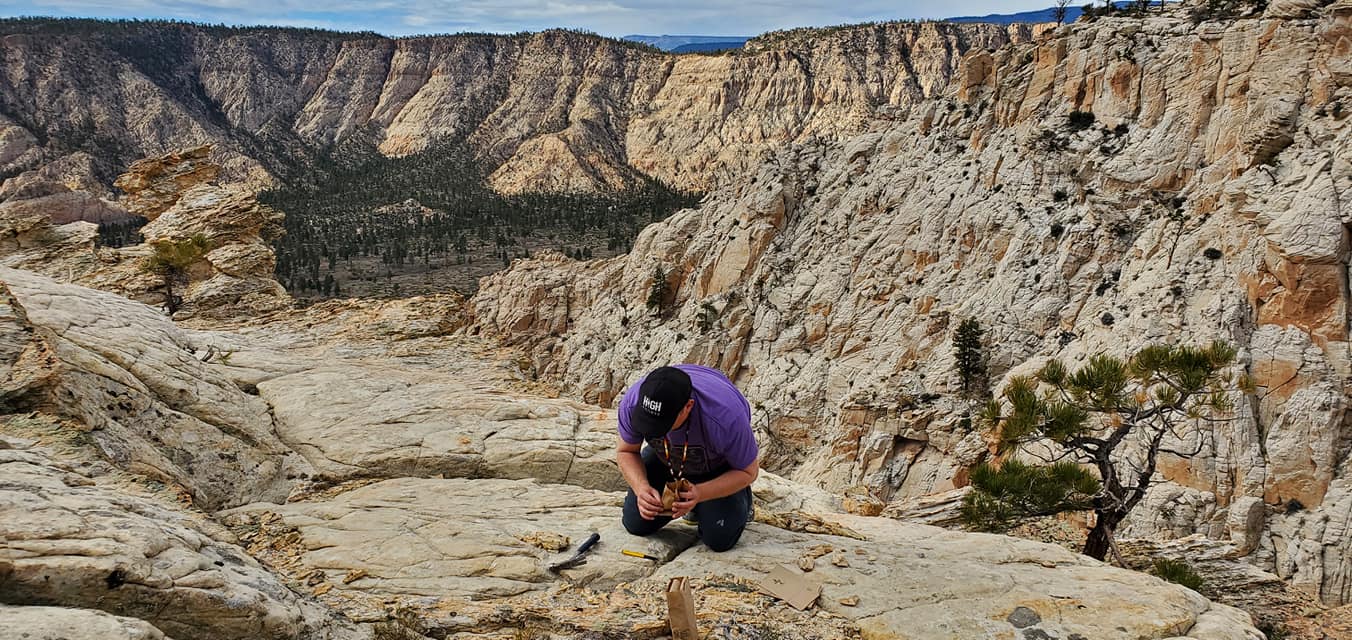Lichens, whether growing on rock or vegetation, play surprising and complex roles in the ecosystem. Steve Leavitt, an evolutionary biologist at Brigham Young University, is the curator of the lichen collection at BYU’s Life Science Museum. This week, we talked with Steve about what lichens are made of and why we should care about the colorful and unique life forms.
Science Moab: Lichens require two organisms—fungus and algae—to exist. How does that work?
Leavitt: One of the partners in a symbiotic relationship, evolutionarily, is always trying to get the upper hand. The iconic image that comes to mind is that they’re getting together and helping each other out, but in reality, it’s more complex than that. With lichen, the fungus is creating a structure that algae can survive in: it’s screening UV radiation and creating a beautiful little growth chamber for the algae. And in return, the algae returns sugars to the fungus. It’s like a fungus discovered farming. There’s something evolutionarily advantageous coming from this specific exchange of goods—so good that lichens have evolved independently multiple times.
Science Moab: What draws some lichens to grow on rocks, as opposed to on living organisms like trees?
Leavitt: The beauty of a rock face, especially something that’s exposed and hot, is that there is no competition. If you can survive, you have the real estate all to yourself. This may be one of the reasons why lichens evolved: those sugars from the algae can actually be used to help protect the entire organism from desiccation. So when the fungus figures out a way to not use those polysaccharides for energy, but rather save them for protection from desiccation, it’s able to colonize these novel and unique habitats. The lichens in other places are surviving in a different niche. But what the two have in common is the reliance on a fungus, an algae, and a whole bunch of microbes to survive. You can have big three-dimensional macrolichens with the same common ancestor as some teeny, tiny crustose lichens that you never see.
Science Moab: So why should people study lichens?
Leavitt: They’re weird, they’re interesting, and they’re part of this incredible array of diversity on Earth. For me, it’s simply that there are questions to answer. We can step back across deeper geologic time and recognize that lichens are fundamentally important for soil formation. They slowly weather or degrade rocks until we end up with productive soils. In other cases, they stabilize soil through biological soil crusts, or they help vascular plants to facilitate more effective water infiltration to retain better moisture in soils. Lichen have some important ecological roles.
Science Moab: What specifically are you studying right now?
Leavitt: I’m into a bit of everything that’s lichen, or even potentially lichen, related! We have some projects going on in the La Sal Mountains where there are big lichens just dripping off conifers. It looks like something you would see in Alaska or British Columbia, and there’s nowhere else in the state where that occurs. So we’re interested in asking, what are those processes that facilitated the formation of these really cool macrolichen communities?
We’re interested in using lichens as biomonitors too—we can go out and collect a lichen that’s been sitting on a rock for the past few decades, grind it up, and analyze the concentrations for potential pollutants like lead, or iron, or titanium. And then we can use those as proxies to look at air quality.
Lichen can also tell us about dust deposition, which actually has some pretty substantial impacts on human health. Different dust sources have different signatures, so we can go through and match up those profiles to dust from a specific region.
Science Moab: These amazing, colorful, different shapes have infinite potential for intricate patterns. Can you tell anything from the visual aspect? Why does lichen have all these different variations?
Leavitt: A lot of the colors we see are produced for sunscreen. If you go out and see a bunch of orange lichens growing on exposed sandstone, it’s likely that those compounds are produced by the fungus as a sunscreen to protect the algae. In other cases, you may see a beautiful green lichen growing on a rock and think it’s the algae that makes it green—but actually, it’s usnic acid that the fungus produces for anti-herbivory, to keep snails from munching on it. The shapes, meanwhile, are for ways of dealing with water or heat.
What we’re seeing is the interaction between multiple organisms that have evolutionary adaptations that allow them to have preferential success, survive, and reproduce.
Science Moab is a nonprofit dedicated to engaging community members and visitors with the science happening in Southeast Utah and the Colorado Plateau. To learn more and listen to the rest of this interview, visit www.sciencemoab.org/radio. This interview has been edited for clarity.




